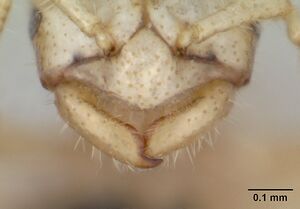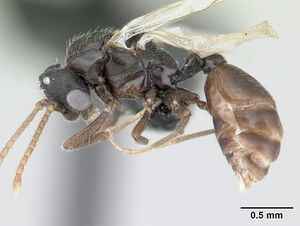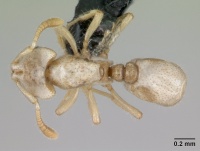Tropidomyrmex elianae
| Tropidomyrmex elianae | |
|---|---|

| |
| Scientific classification | |
| Kingdom: | Animalia |
| Phylum: | Arthropoda |
| Class: | Insecta |
| Order: | Hymenoptera |
| Family: | Formicidae |
| Subfamily: | Myrmicinae |
| Tribe: | Solenopsidini |
| Genus: | Tropidomyrmex |
| Species: | T. elianae |
| Binomial name | |
| Tropidomyrmex elianae Silva, Feitosa, Brandão & Diniz, 2009 | |
The only species of the genus Tropidomyrmex. The type colony was collected from within a termite colony and, very surprisingly, was found to co-exist amicable with the termites. Workers of the ants and termites were observed interacting and even antennating one another.
Identification
Tropidomyrmex can be easily distinguished from all other ant genera by the bilobed subpostpetiolar process. Within solenopsidine genera it is also unique in having mandibles with only a single curved apical tooth.
Distribution
Latitudinal Distribution Pattern
Latitudinal Range: 8.091111111° to -21.09166667°.
| North Temperate |
North Subtropical |
Tropical | South Subtropical |
South Temperate |
- Source: AntMaps
Distribution based on Regional Taxon Lists
Neotropical Region: Brazil (type locality).
Distribution based on AntMaps
Distribution based on AntWeb specimens
Check data from AntWeb
Countries Occupied
| Number of countries occupied by this species based on AntWiki Regional Taxon Lists. In general, fewer countries occupied indicates a narrower range, while more countries indicates a more widespread species. |

|
Estimated Abundance
| Relative abundance based on number of AntMaps records per species (this species within the purple bar). Fewer records (to the left) indicates a less abundant/encountered species while more records (to the right) indicates more abundant/encountered species. |

|
Biology
Silva et al. (2009) - The types of this species were collected by our colleague Dr Eliana M. Cancello, while searching for termites in Serra de Sao Jose, Tiradentes, state of Minas Gerais, southeastern Brazil. She found several ant individuals inside small chambers (c. 2 x 1cm) of a ground nest of Anoplotermes pacificus Fr. Mueller (Isoptera, Apicotermitinae). In the field, Dr Cancello noticed that the ants and termites, and their immatures, shared the same nest chambers. This is a very peculiar observation, as most ant species inquiline in termite nests are known to occupy isolated cavities (Higashi & Ito, 1989; Delabie, 1995; Dejean & Feneron, 1999).
A fragment of the Anoplotermes pacificus nest was brought to the MZSP laboratory, where individuals of both termites and ants were observed interacting and even antennating each other in different chambers. No signal of agonistic behavior was observed. In total three ant workers, six ergatoid gynes, ten alate males, 19 pupae (all males) and four larvae were found. Out of the four larvae, one was singled out for SEM. Two of the three remaining larvae seem to be full grown (length 2.485 and 2.342 mm), while another one showed length of 1.914 mm, possibly representing an earlier stage.
Only two workers are known from collections other than the type series. Both were recovered from different 1 m2 leaf litter samples using Winkler extractors. The first worker came from a sample taken in May, 4, 2005, from relatively deep leaf-litter along a secondary dirt road, bordering a secondary gallery forest along the Vaca Velha stream, a tributary of the Manuel Alves Grande River, in Serra da Cangalha, northeastern state of Tocantins, central Brazil. Out of seven litter samples studied, just one produced a specimen of this species. In a second expedition to the area, we studied 51 similar leaf-litter samples collected some 10 km west of the first locality, out of which another single worker was found. The second locality was covered by a very much altered forest, adjacent to an open Cerrado. It is not easy to imagine the original coverage, but judging from the surrounding environment, it seemed to us that this was originally a full grown Cerrado, also called "Cerradao". From the same group of samples, we collected, for the first time in central Brazil, workers of the worldwide tramp ant Monomorium pharaonis Linnaeus.
Life History Traits
- Mean colony size: ~3 (Greer et al., 2021)
- Compound colony type: not parasitic (Greer et al., 2021)
- Nest site: hypogaeic (Greer et al., 2021)
- Diet class: predator (Greer et al., 2021)
- Foraging stratum: subterranean/leaf litter (Greer et al., 2021)
Castes
Worker
Images from AntWeb

| |
| Queen (brachypterous). Specimen code casent0173620. Photographer April Nobile, uploaded by California Academy of Sciences. | Owned by CAS, San Francisco, CA, USA. |
Male
Images from AntWeb
    
| |
| Paratype of Tropidomyrmex elianae. Male (alate). Specimen code casent0189192. Photographer April Nobile, uploaded by California Academy of Sciences. | Owned by CAS, San Francisco, CA, USA. |
Nomenclature
The following information is derived from Barry Bolton's Online Catalogue of the Ants of the World.
- elianae. Tropidomyrmex elianae Silva, R.R., et al. 2009: 39, figs. 1-11 (w.q.m.l.) BRAZIL (Mato Grosso, Tocantins).
- Type-material: holotype worker, 3 paratype workers, 5 paratype queens, 10 paratype males.
- Type-locality: holotype Brazil: Mato Grosso, Tiradentes, Serra do São José, 1267 m., 12.iv.2007, no. 12 (E.M. Cancello & M.A. Menezes); paratypes with same data.
- Type-depositories: MZSP (holotype); BMNH, CASC, CPDC, ICNB, MZSP, USNM (paratypes).
- Distribution: Brazil.
Unless otherwise noted the text for the remainder of this section is reported from the publication that includes the original description.
Description
Worker
Holotype (paratypes within brackets): HW 0.51 (0.53-0.55); HL 0.55 (0.55-0.56); ML 0.27 (0.26-0.28); EL 0.031 (0.028-0.038); SL 0.27 (0.26-0.28); PRW 0.27 (0.26-0.28); WL 0.65 (0.64-0.66); FL 0.34 (0.30-0.37); PL 0.15 (0.15); PW 0.17 (0.17); PPL 0.11 (0.09-0.11); PPW 0.21 (0.21); GL 0.78 (0.73-0.81); TL 2.51 (2.42-2.57); OI 4.28 (3.87-5.25); SI 52.4 (51.7-53.6); CI 98.3 (96.5-100).
Color pale yellow, with dark punctuations at the hair insertions. Body predominantly smooth and opaque; lateral faces of mesopleuron and propodeum with short, longitudinal rugulation, better seen in SEM. Body covered by abundant, whitish, short, suberect hairs, denser on appendages and anterior portion of pronotum; long, flexuous hairs present on ventral face of head.
Basal margins of mandibles not touching the anterior margins of clypeus when mandibles are closed (intramandibular space present). Compound eyes with four minute facets at the maximum diameter. Pronotum slightly inclined anteriorly; metapropodeal groove not strongly depressed; propodeal spiracle set lower than the adjacent surface of propodeum, directed posterad. Postpetiole broader than petiole and with the anterior margin weakly concave medially, in dorsal view.
Sting apparatus. Spiracular plate subrectangular, extending towards the medial connection; margin of medial connection sclerotized; dorsal notch absent; spiracle relatively wide and set close to the posterior margin of plate; anterior apodeme narrow and largely angulate medially; ventral edge weakly pronounced. Quadrate plate with the dorsal region as broad as ventral region, except for the apodeme; apodeme area smaller than the plate body; dorsal margin convex; apex of anterodorsal corner rounded; posterior margin complete. Oblong plate with posterior apodeme long; subterminal tubercle apically rounded; postincision shallow. Triangular plate longer than broad, without projections. Gonostylus with body virtually fused to the oblong plate, with a single sclerotized anterior segment; eight chaetae present, subequal in length. Anal plate small and subtriangular; arc rounded and sclerotized basally; body of plate not sclerotized; apical margin distally rounded; anal sensillae scarce and restricted to the apex of plate. Lancet short, with functional valves; dorsal and ventral margins converging towards the apex. Sting sclerotized, with acute apex; bulb base continuous, dorsally convex, laterally rounded, and distinct from the sting shaft in profile; body of bulb slender in lateral view; internal apophysis absent; anterolateral processes absent; articular processes distinct; basal notch considerably broad. Furcula with dorsal arm fused to the base of the sting bulb; lateral arms distinct.
Queen
Paratypes: HW 0.53-0.56; HL 0.51-0.56; SL 0.24-0.32; ML 0.26-0.30; EL 0.03-0.05; PRW 0.28-0.36; WL 0.64-0.73; FL 0.36-0.39; PL 0.17-0.21; PW 0.17-0.19; PPL 0.10-0.13; PPW 0.21-0.24; GL 0.56-1.02; TL 2.24-2.95; OI 4.14-6.90; SI 46.4-58.6; CI 96.6-103.7. Ergatoid. Differing from the conspecific worker by the slightly larger size, presence of three relatively small ocelli and wing buds, and by the absence of a promesonotal suture.
Male
Paratypes: HW 0.57-0.66; HL 0.48-0.58; SL 0.11-0.15; ML 0.17-0.21; EL 0.23-0.28; PRW 0.46-0.69; WL 1.01-1.14; FL 0.45-0.58; PL 0.22-0.28; PW 0.14-0.22; PPL 0.14-0.17; PPW 0.17-0.28; GL 0.96-1.31; TL 2.98-3.69; OI 31.75-38.65; SI 20.0-25.0; CI 105.2-129.6.
Body dark brown to blackish, with head slightly darker and appendages somewhat lighter. Head densely punctate; body mostly smooth and shining with some areas finely punctate at inferior portion of pronotum and mesonotum. Short, subdecumbent, whitish hairs sparsely covering the body, more abundant at the dorsum of prescutellum, petiole and postpetiole. Antennal scape and pedicel with only scattered long hairs, while the other segments are covered by minute, dense, pubescence.
Head broader between the superior margins of the bulging compound eyes; posterior margin flat. Mandibles relatively well developed and gently curved ventrally, with a single, acute tooth at apex. Clypeus narrower than in the conspecific gynes, extending posteriorly between the antennal insertions; median area of clypeus elevated, swollen, diamond shaped, with rounded corners, its posterior margin produced and diagonal . Anterior tentorial pits clearly visible (Fig. 7A), about halfway between the antennal sockets and the lateral margins of the clypeus. Labrum emarginate. Dorsal surface of head depressed near the antennal insertions. Apical segment of antennal funiculus as long as the two preceding ones. Ocelli subequal in size.
Pronotum extremely reduced, almost entirely concealed by the scutum; parapsidial lines diverging slightly anteriorly; prescutellum with laterally rounded axillae; scuto-scutellar sulcus shallowly set; scutellum subrounded with the anterior margin wider than posterior; mesopleuron broad, anepisternum triangular, clearly separated from katepisternum by a suture; katepisternum broad, transverse; metanotum reduced to a narrow longitudinal stripe, straight in lateral view; dorsal face of propodeum very short, declivous face almost vertical in lateral view, propodeal spiracle placed far from posterior declivity; metapleuron divided by an oblique groove; metapleural gland opening wide and placed at superior portion of metapleuron. Forewing with a narrow and weakly colored stigma. Longitudinal vein Rs surpassing the stigma but not reaching the distal border of wing; M extending short beyond SR cell; Cu not reaching the inferior margin of wing; A relatively short, not forming the Cu cell.
Petiole with a low, rounded node in lateral view. Postpetiole with anterior and posterior margins subparallel in dorsal view; postpetiolar sternite slightly projected and gently concave medially. Gaster with the segments decreasing in size towards the apex, its maximum width at the gastral segment II.
Larva
Larvae (n=4). Body profile pheidoloid. Head subcircular, ventral, near the anterior end, mounted on short stout prothorax neck; abdomen short, stout and straight; ends rounded. Head with lateral margins gently converging towards the mouthparts; very short mandibles, lobose, slightly curved medially and without distinct apical teeth; labrum narrow and weakly concave anteriorly; clypeus narrow and with dorsal surface bearing three long setae. Trophorhinium clearly visible (Fig. 8B), with dorsal spicules twice as large as ventral ones. Irregular, short, semicircular labrum. Irregularly lobose maxillae with a single apical sensilla, which bears a small spinule. Labium deeply notched in the middle, without spinules; palps anterior. Hypopharynx without spinules. Antennae shape typical of ant larvae in general, only slightly elevated from the cranial surface, without base, well separated, closer to the clypeus than to the occipital margin. Less than 40 unbranched head hairs. Body pilosity sparse and composed of three kinds of hairs: (1) simple, relatively long, slightly curved, filiform hairs, concentrated mainly on body extremities (Fig. 8E); (2) long, suberect, apically bifurcate sometimes tripartite, scarcely distributed on the median segments of body; (3) anchor-like, apically tripartite, short, and arranged in transverse rows on the ventral segments of body (Fig. 8D). Body spiracles not visible in the specimens examined herein; however, this could have been caused by the collapse of larval integument during preparation for SEM. Anus area bears spicules arranged in rows (Fig. 8E).
Type Material
Holotype worker. BRAZIL: MG , Tiradentes , Serra de Sao Jose [ 21°05'30"S44°10'36"W ], 12.iv.2007 , 1267m, Cancello, E.M. & Menezes, M.A. cols. No. 12. Apicotermitinae Museu de Zoologia da Universidade de Sao Paulo. Paratypes . same data as holotype (1 gyne and 1 male) California Academy of Sciences; (1 male) Laboratório de Mirmecologia CEPEC / CPDC; (1 male) The Natural History Museum; (1 male) Museo de Historia Natural, Bogata; (3 workers, 3 gynes, and 5 males) Museu de Zoologia da Universidade de Sao Paulo; (1 gyne and 1 male) National Museum of Natural History.
Etymology
This species is named after the prominent Brazilian termitologist Dr Eliana Cancello, a long term colleague of the Museu de Zoologia da Universidade de Sao Paulo and collector of T. elianae type series.
References
References based on Global Ant Biodiversity Informatics
- Silva R. R., R. M. Feitosa, C. R. F. Brandão, and J. L. M. Diniz. 2009. Tropidomyrmex elianae, a new myrmicine ant genus and species from Brazil, tentatively assigned to Solenopsidini (Hymenoptera, Formicidae). Zootaxa 2052: 32-48.
- Ulyssea M. A., C. R. F. Brandao. 2013. Catalogue of Dacetini and Solenopsidini ant type specimens (Hymenoptera, Formicidae, Myrmicinae) deposited in the Museu de Zoologia da Universidade de Sao Paulo, Brazil. Papies Avulsos de Zoologia 53(14): 187-209.

